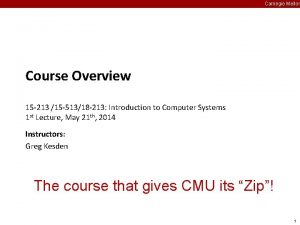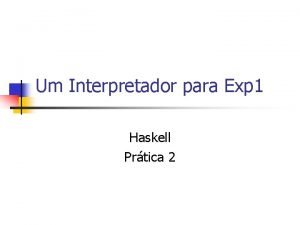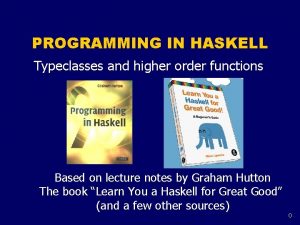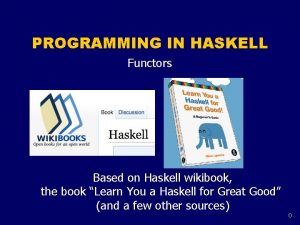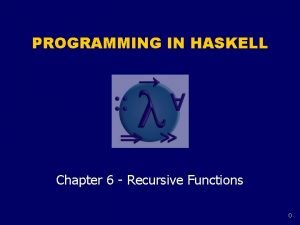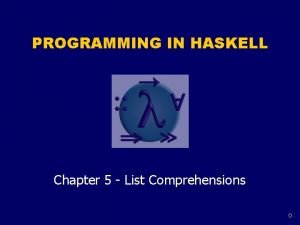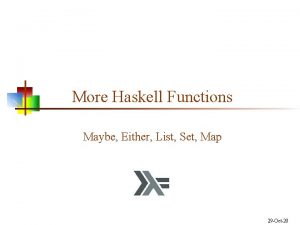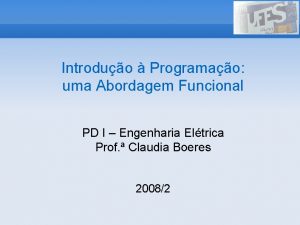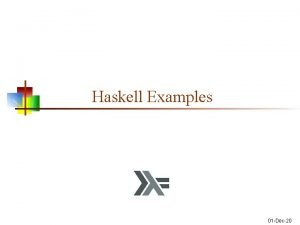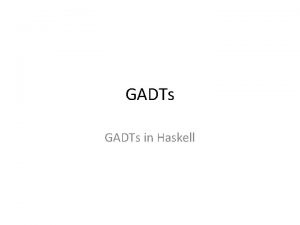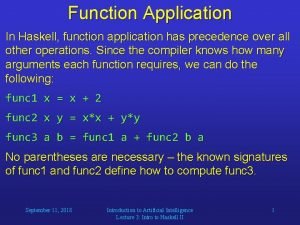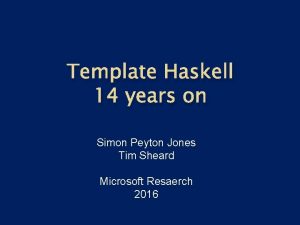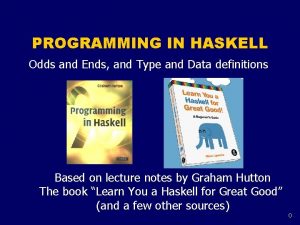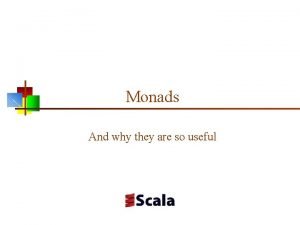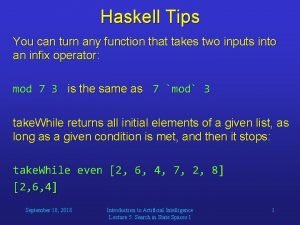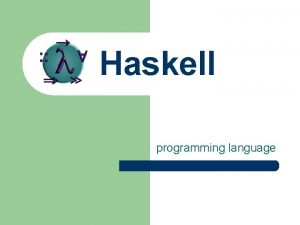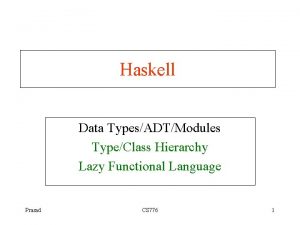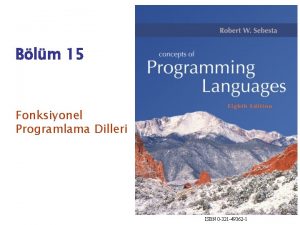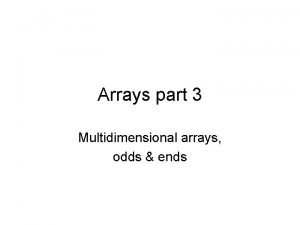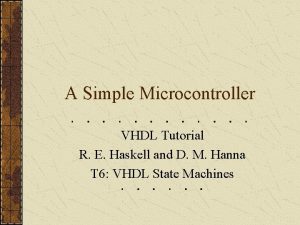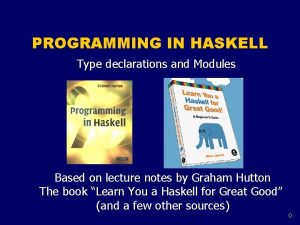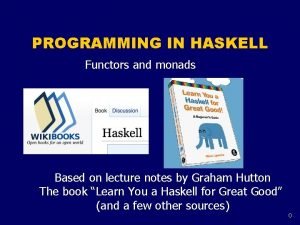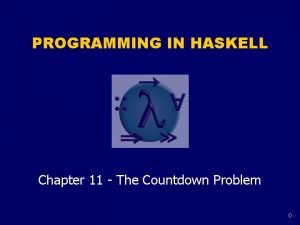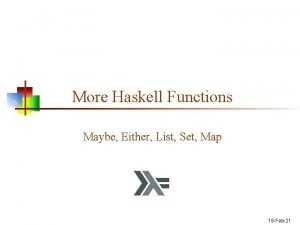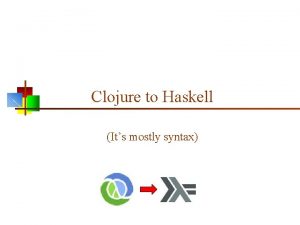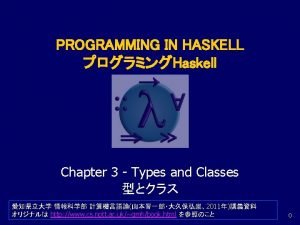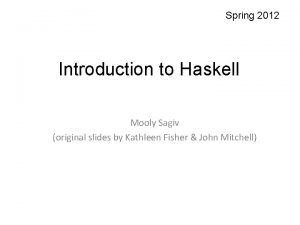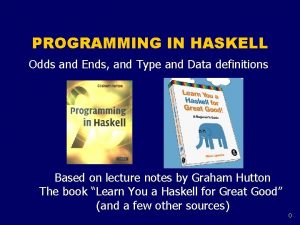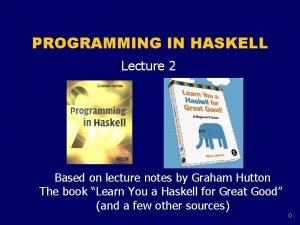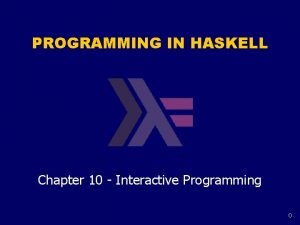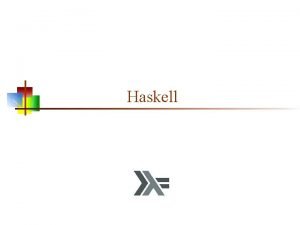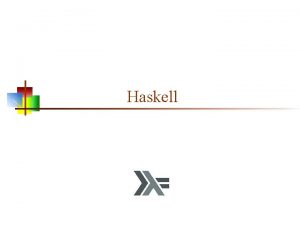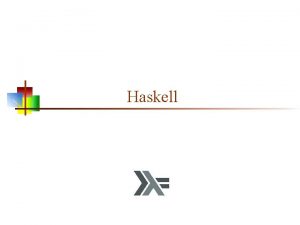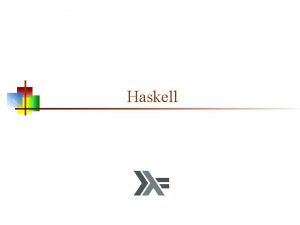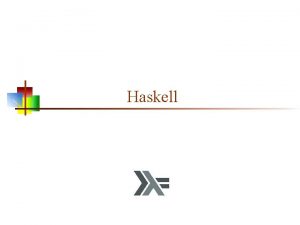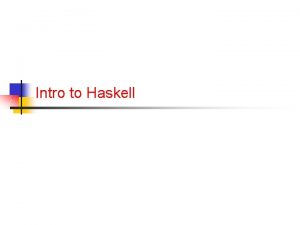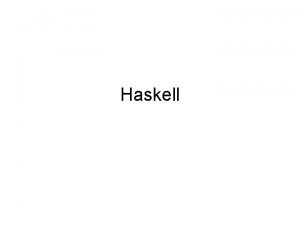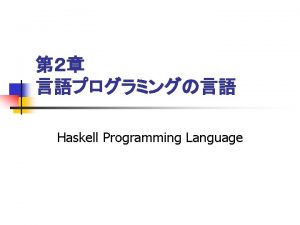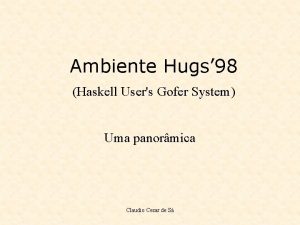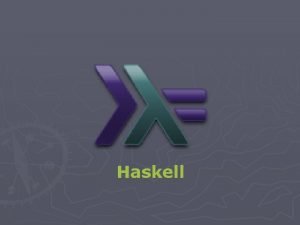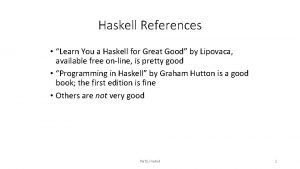Haskell GHC and HUGS n n Haskell 98



















![List Comprehensions I n [ expression_using_x | x <- list ] n n n List Comprehensions I n [ expression_using_x | x <- list ] n n n](https://slidetodoc.com/presentation_image_h2/a1bbfbe5fc501a309eb9981272f27d9a/image-20.jpg)
![List Comprehensions II n n [ expression_using_x_and_y | x <- list, y <- list] List Comprehensions II n n [ expression_using_x_and_y | x <- list, y <- list]](https://slidetodoc.com/presentation_image_h2/a1bbfbe5fc501a309eb9981272f27d9a/image-21.jpg)
![List Comprehensions III n n [ expression_using_x | generator_for_x, test_on_x] take 5 [x*x | List Comprehensions III n n [ expression_using_x | generator_for_x, test_on_x] take 5 [x*x |](https://slidetodoc.com/presentation_image_h2/a1bbfbe5fc501a309eb9981272f27d9a/image-22.jpg)
![List Comprehensions IV n [x+y | x <- [1. . 5], even x, y List Comprehensions IV n [x+y | x <- [1. . 5], even x, y](https://slidetodoc.com/presentation_image_h2/a1bbfbe5fc501a309eb9981272f27d9a/image-23.jpg)











- Slides: 34

Haskell

GHC and HUGS n n Haskell 98 is the current version of Haskell GHC (Glasgow Haskell Compiler, version 7. 4. 1) is the version of Haskell I am using n n n GHCi is the REPL Just enter ghci at the command line HUGS is also a popular version n As far as the language is concerned, there are no differences between the two that concern us. 2

Using Haskell n You can do arithmetic at the prompt: n n You can call functions at the prompt: n n GHCi> : load "~\Desktop\my. Haskell. Programs\h. hs" You can reload definitions from the same file n n GHCi> sqrt 10 3. 16228 You can load definitions from a file: n n GHCi> 2 + 2 4 GHCi> : reload You can define variables directly in GHCi with let n let double x = 2 * x 3

Lexical issues n Haskell is case-sensitive n n n Haskell uses indentation for grouping, not braces n n n Variables begin with a lowercase letter Type names begin with an uppercase letter Braces and semicolons can be used, but it’s not common Tabs can really obscure the indentation; set your text editor to replace tabs with spaces There are two types of comments: n n -- (two hyphens) to end of line {- multi-line {- these may be nested -} -} 4

Semantics n The best way to think of a Haskell program is as a single mathematical expression n In Haskell you do not have a sequence of “statements”, each of which makes some changes in the state of the program Instead you evaluate an expression, which can call functions Haskell is a functional programming language 5

Rules for functions n Functions should be free of side effects n n n A function should not do any input/output A function should not change any state (any external data) Functions should be deterministic: Given the same inputs, a function should produce the same outputs, every time If a function is side-effect free and deterministic, it has referential transparency—all calls to the function could be replaced in the program text by the result of the function But this disallows random numbers, getting the date and time, input and output, etc. —don’t we need those things? 6

Functional Programming (FP) n In FP, n Functions are first-class objects. That is, they are values, just like other objects are values, and can be treated as such n n n Functions can be assigned to variables, Functions can be passed as parameters to higher-order functions, Functions can be returned as results of functions Functions can be manipulated to create new functions There are function literals One author suggests that the most important characteristic of a functional language is that it be single assignment n Everything else (? ) follows from this 7

Types n n Haskell is strongly typed… …but type declarations are seldom needed Primitive types: Int, Float, Char, Bool Lists: [2, 3, 5, 7, 11] n n All list elements must be the same type Tuples: (1, 5, True, 'a') n Tuple elements may be different types 8

Bool Operators n n n Bool values are True and False “And” is infix && “Or” is infix || “Not” is prefix not Functions have types n “Not” is type Bool -> Bool n “And” and “Or” are type Bool -> Bool 9

Arithmetic on Integers n + - * / ^ are infix operators n n even and odd are prefix operators n n Add, subtract, and multiply are type (Num a) => a -> a Divide is type (Fractional a) => a -> a Exponentiation is type (Num a, Integral b) => a -> b -> a They have type (Integral a) => a -> Bool div, quot, gcd, lcm are also prefix n They have type (Integral a) => a -> a 10

Floating-Point Arithmetic n n + - * / ^ are infix operators, with the types specified previously sin, cos, tan, log, exp, sqrt, log 10 n n pi n n Prefix, type (Floating a) => a -> a Type Float truncate n Type (Real. Frac a, Integral b) => a -> b 11

Operations on Chars n n n These operations require import Data. Char ord is Char -> Int chr is Int -> Char is. Print, is. Space, is. Ascii, is. Control, is. Upper, is. Lower, is. Alpha, is. Digit, is. Alpha. Num are all Char-> Bool A string is just a list of Char, that is, [Char] n "abc" == ['a', 'b', 'c'] 12

Polymorphic Functions n == /= n n < <= >= > n n n Equality and inequality tests are type (Eq a) => a -> Bool Other comparisons are type (Ord a) => a -> Bool show will convert almost anything to a string Any operator can be used as infix or prefix n n (+) 2 2 is the same as 2 + 2 100 `mod` 7 is the same as mod 100 7 13

Operations on Lists I 14

Operations on Lists II 15

Operations on Lists III 16

Operations on Tuples …and nothing else, really. 17

Lazy Evaluation n n No value is ever computed until it is needed Lazy evaluation allows infinite lists Arithmetic over infinite lists is supported Some operations must be avoided 18

Finite and Infinite Lists 19
![List Comprehensions I n expressionusingx x list n n n List Comprehensions I n [ expression_using_x | x <- list ] n n n](https://slidetodoc.com/presentation_image_h2/a1bbfbe5fc501a309eb9981272f27d9a/image-20.jpg)
List Comprehensions I n [ expression_using_x | x <- list ] n n n Example: [ x * x | x <- [1. . ] ] n n read: <expression> where x is in <list> x <- list is called a “generator” This is the list of squares of positive integers take 5 [x*x | x <- [1. . ]] n [1, 4, 9, 16, 25] 20
![List Comprehensions II n n expressionusingxandy x list y list List Comprehensions II n n [ expression_using_x_and_y | x <- list, y <- list]](https://slidetodoc.com/presentation_image_h2/a1bbfbe5fc501a309eb9981272f27d9a/image-21.jpg)
List Comprehensions II n n [ expression_using_x_and_y | x <- list, y <- list] take 10 [x*y | x <- [2. . ], y <- [2. . ]] n n take 10 [x * y | x <- [1. . ], y <- [1. . ]] n n [4, 6, 8, 10, 12, 14, 16, 18, 20, 22] [1, 2, 3, 4, 5, 6, 7, 8, 9, 10] take 5 [(x, y) | x <- [1, 2], y <- "abc"] n [(1, 'a'), (1, 'b'), (1, 'c'), (2, 'a'), (2, 'b')] 21
![List Comprehensions III n n expressionusingx generatorforx testonx take 5 xx List Comprehensions III n n [ expression_using_x | generator_for_x, test_on_x] take 5 [x*x |](https://slidetodoc.com/presentation_image_h2/a1bbfbe5fc501a309eb9981272f27d9a/image-22.jpg)
List Comprehensions III n n [ expression_using_x | generator_for_x, test_on_x] take 5 [x*x | x <- [1. . ], even x] n [4, 16, 36, 64, 100] 22
![List Comprehensions IV n xy x 1 5 even x y List Comprehensions IV n [x+y | x <- [1. . 5], even x, y](https://slidetodoc.com/presentation_image_h2/a1bbfbe5fc501a309eb9981272f27d9a/image-23.jpg)
List Comprehensions IV n [x+y | x <- [1. . 5], even x, y <- [1. . 5], odd y] n n [x+y | x <- [1. . 5], y <- [1. . 5], even x, odd y] n n [3, 5, 7, 9] [x+y | y <- [1. . 5], x <- [1. . 5], even x, odd y] n [3, 5, 5, 7, 7, 9] 23

Simple Functions n Functions are defined using = n n avg x y = (x + y) / 2 : type or : t tells you the type n n : t avg (Fractional a) => a -> a 24

Anonymous Functions n n Anonymous functions are used often in Haskell, usually enclosed in parentheses x y -> (x + y) / 2 n the is pronounced “lambda” n n n It’s just a convenient way to type the x and y are the formal parameters Functions are first-class objects and can be assigned n avg = x y -> (x + y) / 2 25

Currying n n n Technique named after Haskell Curry Functions have only one argument Currying absorbs an argument into a function f a b = (f a) b, where (f a) is a curried function (avg 6) 8 n 7. 0 26

Currying example n n “And”, &&, has the type Bool -> Bool x && y can be written as (&&) x y If x is True, (&&)x is a function that returns the value of y If x is False, (&&)x is a function that returns False n It accepts y as a parameter, but doesn’t use its value 27

Slicing n negative = (< 0) Main> negative 5 False Main> negative (-3) True Main> : type negative : : Integer -> Bool Main> 28

Factorial I fact n = if n == 0 then 1 else n * fact (n - 1) This is an extremely conventional definition. 29

Factorial II fact n | n == 0 =1 | otherwise = n * fact (n - 1) Each | indicates a “guard. ” Notice where the equal signs are. 30

Factorial III fact n = case n of 0 -> 1 n -> n * fact (n - 1) This is essentially the same as the last definition. 31

Factorial IV You can introduce new variables with let declarations in expression fact n | n == 0 =1 | otherwise = let m = n - 1 in n * fact m 32

Factorial V You can also introduce new variables with expression where declarations fact n | n == 0 =1 | otherwise = n * fact m where m = n - 1 33

The End 34
 Ghc cmu
Ghc cmu Haskell exp
Haskell exp Higher order function haskell
Higher order function haskell Haskell wikibook
Haskell wikibook Haskell recursive function
Haskell recursive function List comprehension haskell
List comprehension haskell Haskell map lookup
Haskell map lookup Haskell linguagem
Haskell linguagem Operadores logicos haskell
Operadores logicos haskell Factorial haskell
Factorial haskell Adt haskell
Adt haskell Haskell operator precedence
Haskell operator precedence Currying function technique
Currying function technique Visual studio haskell
Visual studio haskell Template haskell quotes
Template haskell quotes Haskell odd
Haskell odd What is a monad haskell
What is a monad haskell Tips for haskell
Tips for haskell Haskell cons
Haskell cons Haskell type hierarchy
Haskell type hierarchy Fonksiyonel programlama
Fonksiyonel programlama Haskell two dimensional array
Haskell two dimensional array Haskell microcontroller
Haskell microcontroller Haskell type declaration
Haskell type declaration Functor laws haskell
Functor laws haskell Higher order functions haskell
Higher order functions haskell Haskell exercises solutions
Haskell exercises solutions Map maybe haskell
Map maybe haskell Clojure haskell
Clojure haskell Haskell bool
Haskell bool Haskell curry
Haskell curry Haskell odds
Haskell odds Haskell
Haskell Haskell
Haskell Samuel haskell
Samuel haskell
